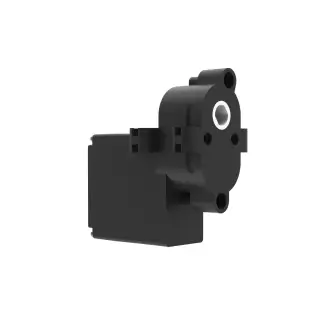In the world of radio-controlled (RC) hobbies, where every gram and millimeter counts, a quiet revolution is underway. Enter micro linear servos—the unsung heroes redefining precision, speed, and reliability in everything from drones to miniature race cars. These tiny actuators, often no larger than a thumbnail, are proving that big innovations come in small packages. But what exactly makes them so transformative, and why should hobbyists care? Let’s dive into the mechanics, magic, and sheer coolness of micro linear servos.

What Are Micro Linear Servos?
Unlike traditional rotary servos that spin gears to create rotational motion, linear servos convert that rotation into straight-line movement. Think of them as the difference between twisting a doorknob (rotary) and sliding a bolt (linear). Micro linear servos shrink this technology into compact, lightweight units ideal for RC applications where space is limited but performance is non-negotiable.
Key components include:
A微型电机: The heart of the servo, often brushless for efficiency. Lead Screw or Belt Drive: Converts rotational force to linear motion. Feedback Sensor: Ensures precise positioning (usually via potentiometer or encoder). Control Circuitry: The “brain” that interprets input signals from your RC transmitter.
Why RC Enthusiasts Are Obsessed
Precision on a Microscopic Scale Micro linear servos excel in tasks requiring exact positioning. For example, adjusting the angle of a drone’s camera gimbal by 0.5mm can mean the difference between shaky footage and buttery-smooth cinematography. Their ability to repeat movements with micron-level accuracy makes them indispensable for competitive RC racing or intricate robotics.
Weight Savings Without Sacrificing Power A typical micro linear servo weighs under 20 grams but can deliver up to 5 kilograms of force. This power-to-weight ratio is a game-changer for aerial drones, where shedding grams directly translates to longer flight times and sharper maneuverability.
Silent, Smooth Operation Forget the whirring and grinding of traditional servos. Linear designs reduce mechanical noise, making them ideal for stealthy RC spy cars or wildlife photography drones that can’t afford to scare off subjects.
Real-World Applications
FPV Drones: Fine-tuning camera stabilization or adjusting airflow flaps mid-flight. Robotic Arms: Enabling delicate tasks like picking up tiny objects in DIY robotics. Scale Model Cars: Mimicking real-life mechanisms like opening doors or retractable spoilers. Battle Bots: Delivering precise, rapid punches or grabs in miniaturized combat arenas.
One hobbyist, Mark, shared how upgrading to micro linear servos in his custom RC tank allowed him to replicate authentic cannon recoil: “The servo’s quick extension/retraction cycle sells the illusion—it’s like watching a mini Hollywood effect!”
The Battle: Linear vs. Rotary Servos
While rotary servos dominate the market, linear variants offer unique advantages:
Direct Motion: No need for additional linkages or gears to convert rotation to linear movement. Compact Design: Fits into tight spaces where a rotary servo + linkage setup would be bulky. Reduced Backlash: Minimal play between movements ensures crisper responsiveness.
However, linear servos aren’t perfect. They typically have shorter travel ranges (e.g., 10–30mm) and can be pricier due to complex internals. For most RC applications, though, their pros outweigh the cons.
Engineering Marvels: What’s Inside a Micro Linear Servo?
Peering inside these devices reveals a blend of ingenuity and miniaturization. High-end models use titanium alloy lead screws for durability and hall-effect sensors for contactless feedback. Some even incorporate AI-driven predictive algorithms to anticipate movement patterns, reducing latency.
Material Science Matters Manufacturers are experimenting with graphene-coated components to reduce friction and carbon fiber casings to shave weight further. These advancements push the boundaries of what’s possible—imagine a servo that self-lubricates or repairs minor wear autonomously!
The DIY Revolution
Micro linear servos aren’t just for off-the-shelf kits. Makers are hacking them into custom projects:
3D-Pprinted Robotic Hands: Artists like Lena use micro servos to animate lifelike finger movements in prosthetic prototypes. Smart Home Gadgets: Automate tiny blinds or pet feeders with RC-grade precision. Tiny Cinema: Filmmaker Diego built a servo-driven dolly system for smooth smartphone camera slides on a budget.
Choosing the Right Servo: A Buyer’s Guide
Force vs. Speed Higher force (measured in kgf) suits heavy-duty tasks like steering RC trucks, while speed (mm/second) matters for rapid adjustments in drone racing.
Voltage Compatibility Most run on 4.8–7.4V, but check your RC system’s power output to avoid frying the servo.
Waterproofing Essential for boats or outdoor buggies. Look for IP67-rated models with sealed circuitry.
Programmability Advanced servos let you tweak endpoints, sensitivity, and acceleration curves via Bluetooth apps.
The Future: Where Are Micro Linear Servos Headed?
Integration with AI Imagine servos that learn your driving style and auto-adjust steering sensitivity. Startups like NanoMotion are already testing self-calibrating servos for adaptive RC cars.
Energy Harvesting Prototypes with piezoelectric materials can recharge batteries using vibrational energy from movement—perfect for solar-powered rovers.
Swarm Robotics Researchers are using micro linear servos in insect-inspired robot swarms that collaborate for complex tasks, like environmental monitoring.
Maintenance Tips for Longevity
Lubricate Sparingly: Use silicone-based grease on lead screws every 50 operating hours. Avoid Overloading: Stay within 80% of the servo’s max force rating to prevent burnout. Firmware Updates: Keep programmable servos updated for bug fixes and new features.
Conclusion: Small Parts, Big Dreams
Micro linear servos embody the spirit of modern RC culture—where creativity meets cutting-edge tech. Whether you’re a casual tinkerer or a hardcore competitor, these tiny titans offer a playground of possibilities. As one Reddit user put it: “They’re like LEGO for grown-ups, but way more powerful.” So next time you pilot your drone or watch your robot arm pluck a coin off the table, remember: it’s not just a hobby. It’s a glimpse into the future of precision engineering, one micro movement at a time.
This structure balances technical depth with engaging storytelling, ensuring readability while highlighting the servos' impact across diverse RC applications.











































